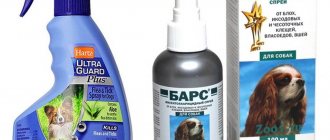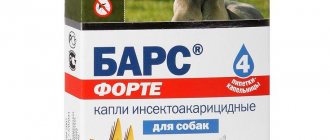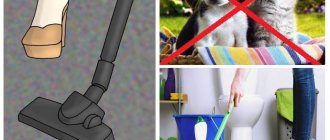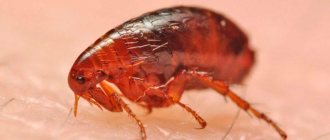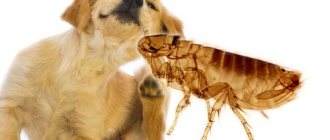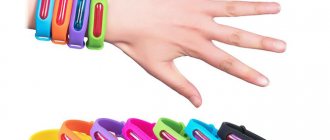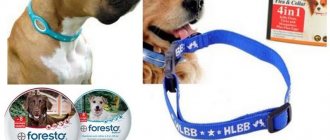The situation is not pleasant when fleas are suddenly discovered on a recently purchased puppy, and even more so in a litter, given that the younger the baby is, the smaller the choice of suitable means for removing bloodsuckers.
In many ways, the method of ridding a dog of fleas that plague him will also depend on where the baby is kept - in an apartment or on the street.
To no less an extent, the choice of means for baiting parasites is influenced by the circumstance - whether the puppy is in the litter with its mother or has already been separated from its family and is living with new owners.
How dangerous are bloodsuckers?
Bloodsuckers can cause a number of diseases and complications. To minimize the risk, they need to be eliminated quickly. They should also be feared because:
Bloodsuckers can cause a number of diseases and complications
- they carry a large number of diseases, even fatal cases occur;
- due to the fact that babies do not have enough red blood cells, a large number of insects causes anemia;
- due to the saliva of parasites, allergies appear (itching, redness, other symptoms);
- bites lead to infection or dermatitis;
- blood-sucking insects are carriers of helminths.
Fleas are especially dangerous in a puppy under 1 month of age, since the baby does not yet have the proper immunity. There is a high risk of complications of the disease, sometimes leading to death.
Advertising:
Where do fleas come from in puppies?
No dog is immune to these parasites, and there are many ways a puppy can pick them up. Moreover, the older the animal, the more variants of infection there are. Here are the main ones:
- In newborn puppies, infection from the mother is most likely;
- the puppy, which was handed over to new owners, could still have eggs or larvae of the parasite, which began to multiply and pester the baby more;
- it is quite possible that the first time your pet walks outside, a flea will cling to it;
- if other animals are found in the room with the dog, then there is a chance of infection from them;
- it is possible that the parasites could transfer to the baby from the owner’s clothes or shoes;
Due to these factors, it is necessary to closely monitor the puppy and other pets, periodically checking them for the presence of bloodsuckers, so that if insects are present, treatment can be started in the early stages.
Protection methods
There are several ways to remove fleas from a 1 month old puppy. At home, this is done using special devices (shampoos, drops, collars) or folk methods.
Fleas are especially dangerous in a puppy under 1 month of age, since the baby does not yet have the proper immunity.
The first thing you should pay attention to is the age of the animal. For a one-month-old puppy (up to six weeks), regular bathing is sufficient. The water should be at a suitable temperature - 37-40°C. The animal's fur must be wetted, keeping its head above the water, and then wiped thoroughly (most importantly, gently). Immediately after this, wrap it in a towel and dry it well. Then you need to carefully comb the fur with a special comb. When everything is done, you need to look at your pet's skin and then manually remove any remaining insects.
This happens: the animal experiences itching, but there are no parasites. It turns out that there are a number of factors that cause itching in a small pet. These include:
- stress;
- ectoparasites;
- allergies;
- a number of skin diseases;
- hyperfunction of the sebaceous glands;
- endocrine pathologies;
- reproductive system problems;
- the presence of malignant processes.
Today there are a large number of drugs that can be used to treat young dogs.
It is almost impossible to identify all diseases on your own. Therefore, when you first notice how your animal is constantly itching, you need to seek help from a veterinarian. He will accurately determine the cause of the discomfort.
How to remove a tick
If you find a tick attached to your dog, do not pull it out under any circumstances. To remove it:
- Take tweezers and grab the tick as close to the skin as possible.
- Gently pull out the tick by turning it clockwise or counterclockwise.
- Do not pull sharply upward or loosen the tick, otherwise you will tear off its head, which will remain in the body. He may also get scared and inject dangerous saliva into the blood.
To make removing a tick easier, buy a special device in the store in advance and follow the instructions.
Rating of the best drugs
Today there are a large number of drugs that can be used to treat young dogs. However, despite all the diversity, it is quite difficult to remove parasites, so you need to know exactly which remedy is best.
All drugs are divided into several groups:
- shampoos;
- drops;
- sprays;
- solutions (for example, hellebore water);
- collars.
The undisputed leader among shampoos is Beaphar.
The undisputed leader among shampoos is Beaphar. This is confirmed by numerous certificates, as well as the great popularity of the company’s products. Animal shampoo has four levels of action:
- Fight against parasites.
- Preventing re-infection.
- Cleaning areas where an infected puppy has been.
- Deworming.
Shampoo is used once. It is important to avoid contact with the mucous membranes of the eyes, ears or tongue.
Drops are no less effective. This product is applied only to the neck area - where the dog cannot reach with its tongue and paws. This is necessary to prevent the pet from licking the poison. Babies can be given drips from the age of one month. The animal should not get wet for 24 hours after the procedure, so you should not bathe it or walk with it in the rain. To get the best effect, the animal can be treated several times.
Shampoo is used once. It is important to avoid contact with the mucous membranes of the eyes, ears or tongue.
The third option is a special collar for your pet. It is used for the prevention of infection rather than for treatment. You can be sure that there are no fleas if you constantly follow preventive measures. The collar can be used at any age, which is especially suitable for small pets.
The choice of other options is large - drops, solutions, and shampoos. What is the best flea treatment for puppies? The question is controversial. It is advisable to use several options.
Preventive measures
To prevent your puppy from becoming infected with fleas, take the following preventive measures:
- The place where the pet is kept is kept clean.
- Regularly inspect the animal for pests.
- Contact with street animals is not allowed.
- After returning from the street, shoes are thoroughly washed.
- If necessary, use antiparasitic drugs.
Insectoacaricidal drugs are used in the dosage prescribed by the veterinarian. If symptoms of intoxication appear (vomiting, nausea, excessive drooling, rapid breathing), the puppy is shown to a doctor.
Traditional methods
If you do not trust radical drugs, there are a large number of folk remedies that allow you to get rid of fleas without harming puppies. Often these are homemade lotions, shampoos or sprays that have a negative effect on insects.
Note: such folk remedies for fleas for small dogs should be made only from fresh ingredients, without an allergic reaction.
Here are a few recipes that can destroy bloodsuckers:
- Herbal decoction. They use wormwood, calamus, tansy, mint, wild rosemary. The herbs are boiled together, or only one of the listed ones is taken. It is important that the broth is strong and warm. We wet the dog's fur, raising his head above the water. Keep for 15 minutes. Afterwards, wipe thoroughly with a towel. Comb out. The product is an excellent substitute for shampoo thanks to the natural ingredients of the decoction.
- Tar soap. The pet must be wet, thoroughly soaped, wrapped in film and then with a towel. Keep it like this for up to 20 minutes. Rinse off the soap, dry the animal with a towel, and comb it out.
These two methods are the most effective. With their help, you will be able to overcome the bloodsuckers without harm to the baby.
Prevention measures are directly determined by where the dog is - in a new family, where he is alone, or together with his relatives.
Prevention
Prevention measures are directly determined by where the dog is - in a new family, where he is alone, or together with his relatives.
In the first case, fleas should be poisoned using medications. They are also used for prevention. In this case, collars are best suited.
When the pet is with the family, all toxic substances must be excluded. Drugs from the skin of some dogs, when washed by the mother, can get into other babies. This will lead to their poisoning or even death. Therefore, it is necessary to use natural preparations here.
It is best to use the scents of wormwood, mint, lavender, bedbug, sweet clover, tansy or flea beetle. The herbs themselves, their oils or powders should be scattered on the floor of the room where the pets spend the most time. The outer part of the lounger (the one that touches the floor) is impregnated with herbal oils. The strong aroma will repel insects.
It is best to use the scents of wormwood, mint, lavender, bedbug, sweet clover, tansy or flea beetle.
How to protect babies under 1 month from bloodsuckers?
Babies are especially helpless in front of insects. Most flea treatments are not available for puppies under 1 month of age. They are commercially available, but cannot be used at such an early age. During the first 4-5 weeks, a small dog develops its own immunity, and then the work of the immune system begins.
However, how then can you get rid of fleas on a puppy? It is necessary to resort to a folk remedy for fleas - a strong decoction or tar soap. First of all, it is advisable to try decoctions, since they are not so “nuclear” and are easier for the baby to tolerate.
The danger of fleas for puppies
For a young and unformed puppy, a flea bite is more dangerous than for an adult dog. Not only the severe itching, which bothers even older dogs, and even makes a small dog whine, but also a number of other reasons are dangerous for the baby.
- the young pet’s immune system is not yet fully formed, and they are completely defenseless against infectious agents that are transmitted by parasites through a bite;
- the puppy’s skin is still very tender and therefore will suffer more from allergic reactions to flea saliva;
- with severe infection, significant blood loss and anemia may occur;
- worms, which can be contracted from fleas, deplete the dog’s body;
If your pet often itches and bites itself, then you need to carefully examine it, and if parasites are found, immediately begin to remove them. Also, before mating, it would be better to treat the mother of the offspring with a long-acting agent so that she and the future offspring are protected during pregnancy and lactation.
Protection for 2 months
Almost everyone knows how to remove fleas from a 2-month-old puppy. A strengthened body can withstand a number of treatments without any problems, namely shampoos, sprays, drops and collars.
The first product used is chosen to be as soft as possible.
Important: all substances must be as natural as possible. More persistent poisons are allowed from the age of 5 months.
The first product used is chosen to be as soft as possible. It is advisable to start with shampoos and consolidate the results with a collar. You only need to put a flea collar on a dry pet, so there is no need to bathe him beforehand.
However, remember that it is not only the pet that needs to be treated, but also the place where it lives.
Symptoms and external signs
The first and main sign that your pet has fleas is its constant scratching. He can also chew his fur. And it is possible to find out whether the puppy was really attacked by parasites only through a detailed examination. You can comb against the grain to check for the presence or absence of bloodsuckers. They usually like to be located behind the ears, as this area has thinner skin and is easier to bite.
Fleas can also be detected during water procedures. Insects will jump off the pet or try to move to drier parts of the body.
Flea saliva causes very strong allergic reactions in babies, so redness will be another symptom. Sometimes it happens that due to the negative effects of parasites, hair loss may occur. Therefore, it is worth closely monitoring changes in the dog’s behavior and appearance.
Read Etiology of actinomycosis in dogs: signs, therapy and prevention
Protection for 3 months
Treat animals 3-5 months old. permissible with all arsenal of means. Moreover, it is allowed to use more durable and strong products that will destroy all insects in just one procedure.
You only need to put a flea collar on a dry pet, so there is no need to bathe him beforehand.
When choosing flea treatments for puppies over 2 months of age, pay attention to the indicated age and weight of the pet, ingredients, method of application, and speed of action.
Important: the chosen option must act gently. Rapid action indicates a strong poison that will harm a small animal.
User reviews
Marta, 32 years old: “I was advised to use a collar for my Marsik as a preventive measure. However, for a long time I wondered: “When can I put a flea collar on a small puppy?” The internal struggle in me was resolved by a pharmacist who also has a pet. I’ll be honest, I changed collars several times over the course of a year, but I never regretted my choice.”
Oksana, 28 years old: “With the advent of the little Rottweiler, I was interested in only one question: “Can one-month-old puppies be treated for fleas?” And if so, then with what. I chose the best option - Beaphar shampoo. To be more reliable, I used it twice, and now there are no insects on our baby.”

